2006 DODGE RAM SRT-10 light
[x] Cancel search: lightPage 1314 of 5267
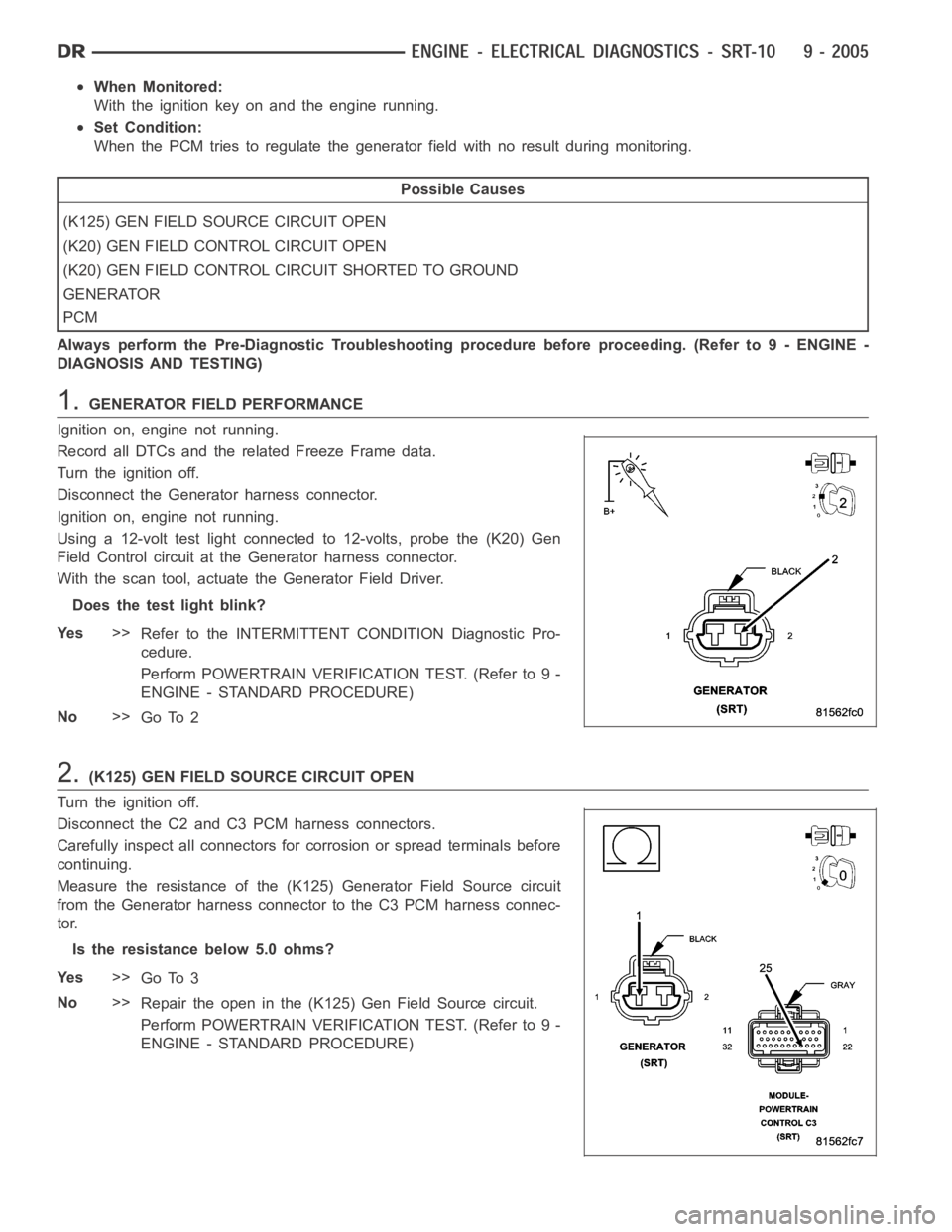
When Monitored:
With the ignition key on and the engine running.
Set Condition:
When the PCM tries to regulate the generator field with no result during monitoring.
Possible Causes
(K125) GEN FIELD SOURCE CIRCUIT OPEN
(K20) GEN FIELD CONTROL CIRCUIT OPEN
(K20) GEN FIELD CONTROL CIRCUIT SHORTED TO GROUND
GENERATOR
PCM
Always perform the Pre-Diagnostic Troubleshooting procedure before proceeding. (Refer to 9 - ENGINE -
DIAGNOSIS AND TESTING)
1.GENERATOR FIELD PERFORMANCE
Ignition on, engine not running.
Record all DTCs and the related Freeze Frame data.
Turn the ignition off.
Disconnect the Generator harness connector.
Ignition on, engine not running.
Using a 12-volt test light connected to 12-volts, probe the (K20) Gen
Field Control circuit at the Generator harness connector.
With the scan tool, actuate the Generator Field Driver.
Does the test light blink?
Ye s>>
Refer to the INTERMITTENT CONDITION Diagnostic Pro-
cedure.
Perform POWERTRAIN VERIFICATION TEST. (Refer to 9 -
ENGINE - STANDARD PROCEDURE)
No>>
Go To 2
2.(K125) GEN FIELD SOURCE CIRCUIT OPEN
Turn the ignition off.
Disconnect the C2 and C3 PCM harness connectors.
Carefully inspect all connectors for corrosion or spread terminals before
continuing.
Measure the resistance of the (K125) Generator Field Source circuit
from the Generator harness connector to the C3 PCM harness connec-
tor.
Is the resistance below 5.0 ohms?
Ye s>>
Go To 3
No>>
Repair the open in the (K125) Gen Field Source circuit.
Perform POWERTRAIN VERIFICATION TEST. (Refer to 9 -
ENGINE - STANDARD PROCEDURE)
Page 1319 of 5267
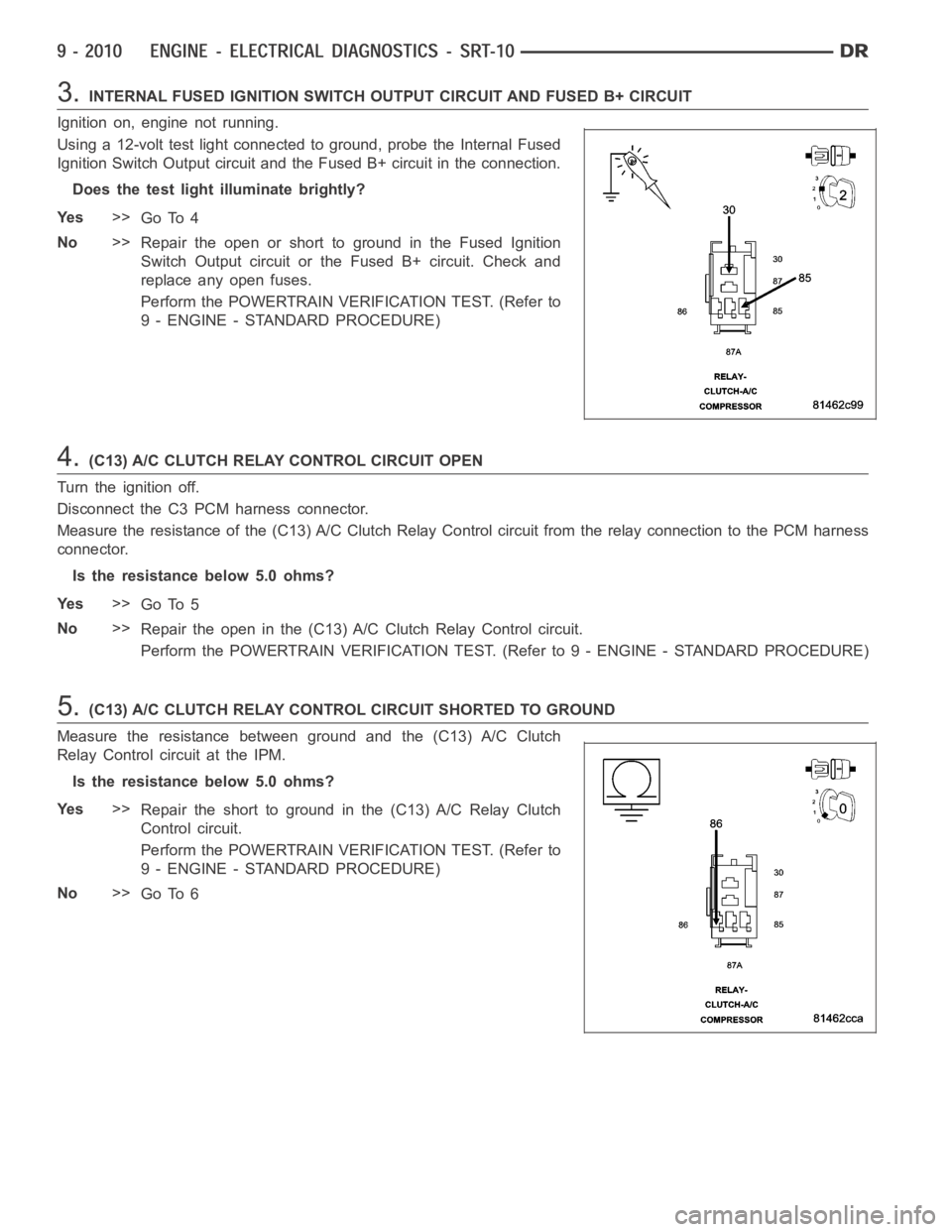
3.INTERNAL FUSED IGNITION SWITCH OUTPUT CIRCUIT AND FUSED B+ CIRCUIT
Ignition on, engine not running.
Using a 12-volt test light connected to ground, probe the Internal Fused
Ignition Switch Output circuit and the Fused B+ circuit in the connection.
Does the test light illuminate brightly?
Ye s>>
Go To 4
No>>
Repair the open or short to ground in the Fused Ignition
Switch Output circuit or the Fused B+ circuit. Check and
replace any open fuses.
Perform the POWERTRAIN VERIFICATION TEST. (Refer to
9 - ENGINE - STANDARD PROCEDURE)
4.(C13) A/C CLUTCH RELAY CONTROL CIRCUIT OPEN
Turn the ignition off.
Disconnect the C3 PCM harness connector.
Measure the resistance of the (C13) A/C Clutch Relay Control circuit from the relay connection to the PCM harness
connector.
Is the resistance below 5.0 ohms?
Ye s>>
Go To 5
No>>
Repair the open in the (C13) A/C Clutch Relay Control circuit.
Perform the POWERTRAIN VERIFICATION TEST. (Refer to 9 - ENGINE - STANDARD PROCEDURE)
5.(C13) A/C CLUTCH RELAY CONTROL CIRCUIT SHORTED TO GROUND
Measure the resistance between ground and the (C13) A/C Clutch
Relay Control circuit at the IPM.
Is the resistance below 5.0 ohms?
Ye s>>
Repair the short to ground in the (C13) A/C Relay Clutch
Control circuit.
Perform the POWERTRAIN VERIFICATION TEST. (Refer to
9 - ENGINE - STANDARD PROCEDURE)
No>>
Go To 6
Page 1322 of 5267
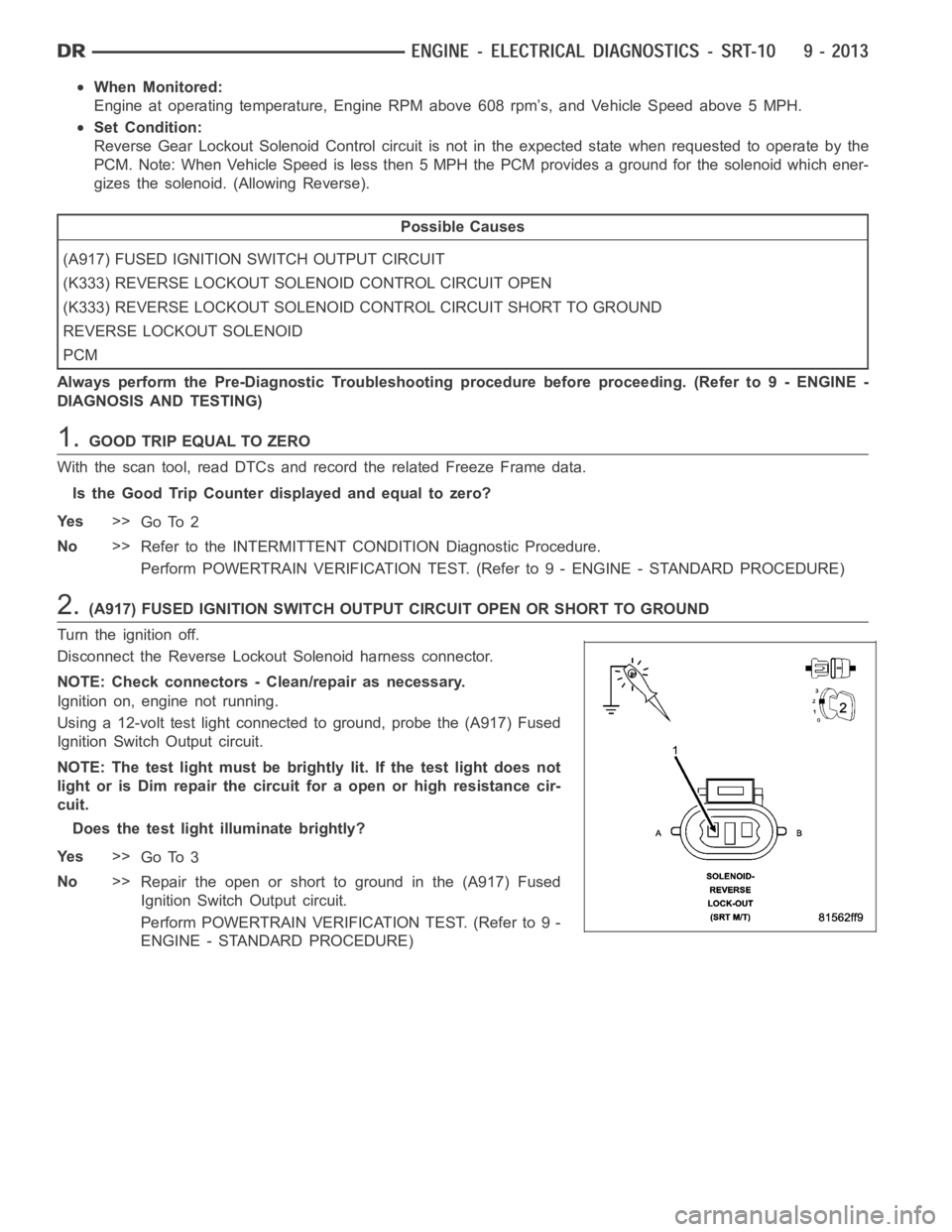
When Monitored:
Engine at operating temperature, Engine RPM above 608 rpm’s, and Vehicle Speed above 5 MPH.
Set Condition:
Reverse Gear Lockout Solenoid Control circuit is not in the expected statewhen requested to operate by the
PCM. Note: When Vehicle Speed is less then 5 MPH the PCM provides a ground forthe solenoid which ener-
gizes the solenoid. (Allowing Reverse).
Possible Causes
(A917) FUSED IGNITION SWITCH OUTPUT CIRCUIT
(K333) REVERSE LOCKOUT SOLENOID CONTROL CIRCUIT OPEN
(K333) REVERSE LOCKOUT SOLENOID CONTROL CIRCUIT SHORT TO GROUND
REVERSE LOCKOUT SOLENOID
PCM
Always perform the Pre-Diagnostic Troubleshooting procedure before proceeding. (Refer to 9 - ENGINE -
DIAGNOSIS AND TESTING)
1.GOOD TRIP EQUAL TO ZERO
With the scan tool, read DTCs and record the related Freeze Frame data.
Is the Good Trip Counter displayed and equal to zero?
Ye s>>
Go To 2
No>>
Refer to the INTERMITTENT CONDITION Diagnostic Procedure.
Perform POWERTRAIN VERIFICATION TEST. (Refer to 9 - ENGINE - STANDARD PROCEDURE)
2.(A917) FUSED IGNITION SWITCH OUTPUT CIRCUIT OPEN OR SHORT TO GROUND
Turn the ignition off.
Disconnect the Reverse Lockout Solenoid harness connector.
NOTE: Check connectors - Clean/repair as necessary.
Ignition on, engine not running.
Using a 12-volt test light connected to ground, probe the (A917) Fused
Ignition Switch Output circuit.
NOTE: The test light must be brightly lit. If the test light does not
light or is Dim repair the circuit for a open or high resistance cir-
cuit.
Does the test light illuminate brightly?
Ye s>>
Go To 3
No>>
Repair the open or short to ground in the (A917) Fused
Ignition Switch Output circuit.
Perform POWERTRAIN VERIFICATION TEST. (Refer to 9 -
ENGINE - STANDARD PROCEDURE)
Page 1326 of 5267
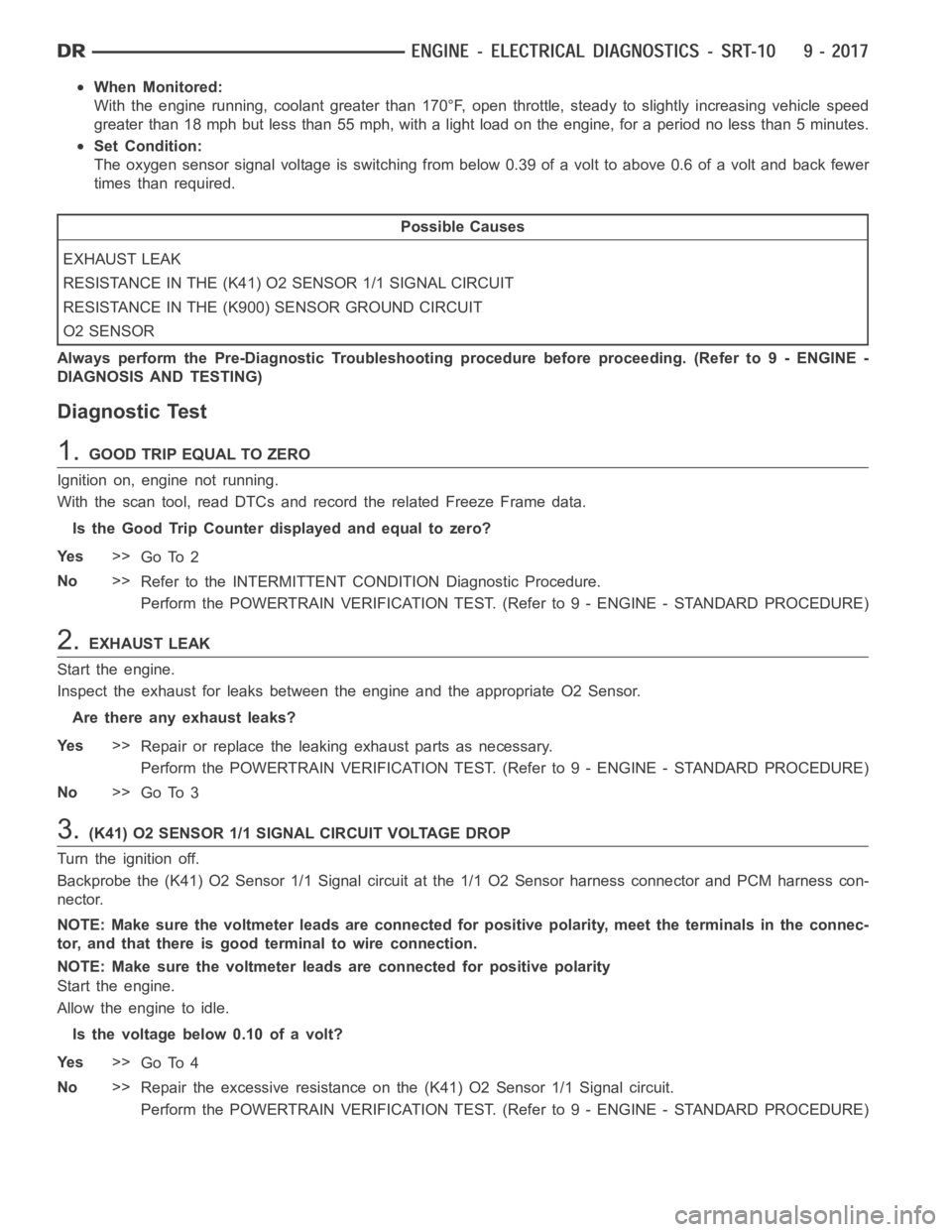
When Monitored:
With the engine running, coolant greater than 170°F, open throttle, steady to slightly increasing vehicle speed
greater than 18 mph but less than 55 mph, with a light load on the engine, for aperiod no less than 5 minutes.
Set Condition:
The oxygen sensor signal voltage is switching from below 0.39 of a volt to above 0.6 of a volt and back fewer
times than required.
Possible Causes
EXHAUST LEAK
RESISTANCE IN THE (K41) O2 SENSOR 1/1 SIGNAL CIRCUIT
RESISTANCE IN THE (K900) SENSOR GROUND CIRCUIT
O2 SENSOR
Always perform the Pre-Diagnostic Troubleshooting procedure before proceeding. (Refer to 9 - ENGINE -
DIAGNOSIS AND TESTING)
Diagnostic Test
1.GOOD TRIP EQUAL TO ZERO
Ignition on, engine not running.
With the scan tool, read DTCs and record the related Freeze Frame data.
Is the Good Trip Counter displayed and equal to zero?
Ye s>>
Go To 2
No>>
Refer to the INTERMITTENT CONDITION Diagnostic Procedure.
Perform the POWERTRAIN VERIFICATION TEST. (Refer to 9 - ENGINE - STANDARD PROCEDURE)
2.EXHAUST LEAK
Start the engine.
Inspect the exhaust for leaks between the engine and the appropriate O2 Sensor.
Are there any exhaust leaks?
Ye s>>
Repair or replace the leaking exhaust parts as necessary.
Perform the POWERTRAIN VERIFICATION TEST. (Refer to 9 - ENGINE - STANDARD PROCEDURE)
No>>
Go To 3
3.(K41) O2 SENSOR 1/1 SIGNAL CIRCUIT VOLTAGE DROP
Turn the ignition off.
Backprobe the (K41) O2 Sensor 1/1 Signal circuit at the 1/1 O2 Sensor harness connector and PCM harness con-
nector.
NOTE: Make sure the voltmeter leads are connected for positive polarity, meet the terminals in the connec-
tor, and that there is good terminal to wire connection.
NOTE: Make sure the voltmeter leads are connected for positive polarity
Start the engine.
Allow the engine to idle.
Is the voltage below 0.10 of a volt?
Ye s>>
Go To 4
No>>
Repair the excessive resistance on the (K41) O2 Sensor 1/1 Signal circuit.
Perform the POWERTRAIN VERIFICATION TEST. (Refer to 9 - ENGINE - STANDARD PROCEDURE)
Page 1329 of 5267
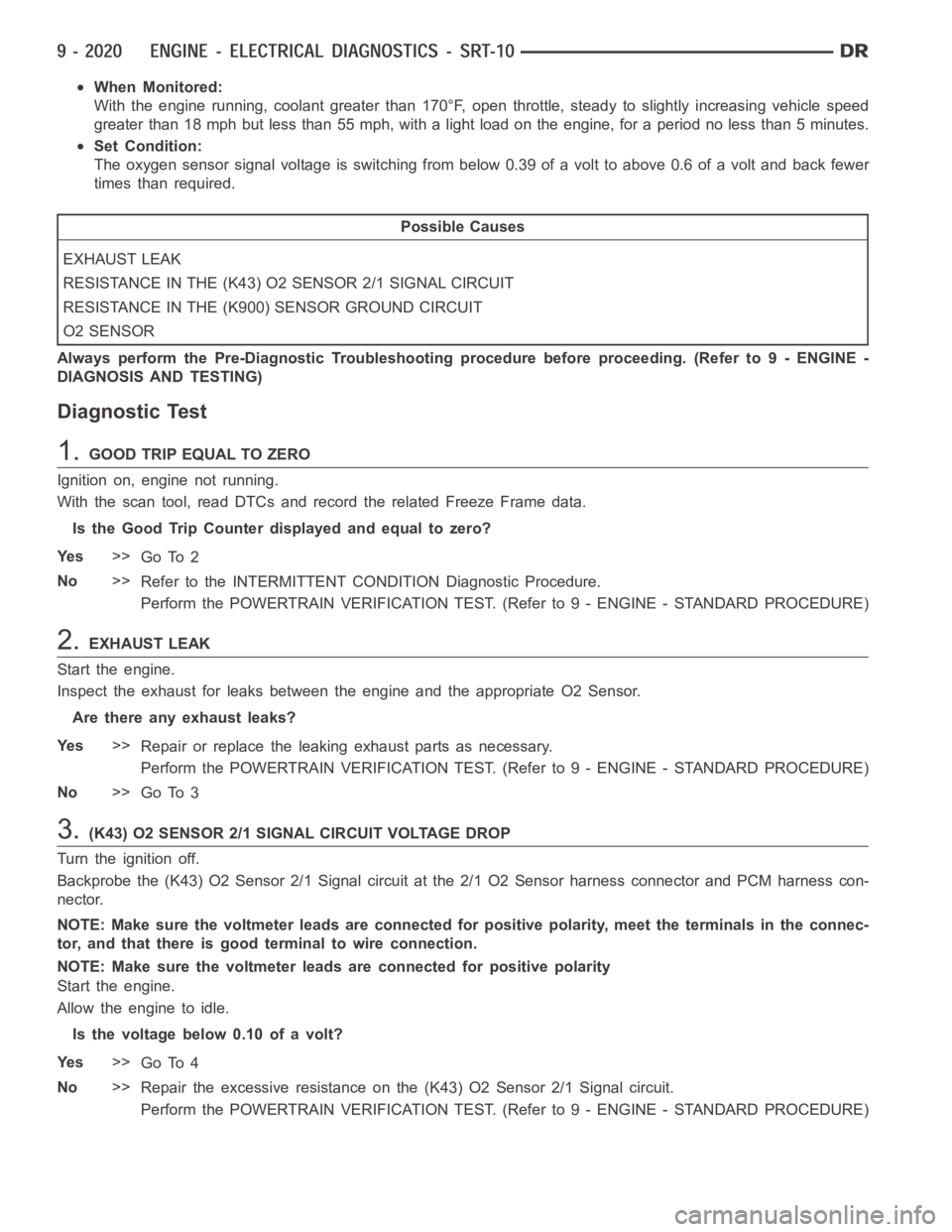
When Monitored:
With the engine running, coolant greater than 170°F, open throttle, steady to slightly increasing vehicle speed
greater than 18 mph but less than 55 mph, with a light load on the engine, for aperiod no less than 5 minutes.
Set Condition:
The oxygen sensor signal voltage is switching from below 0.39 of a volt to above 0.6 of a volt and back fewer
times than required.
Possible Causes
EXHAUST LEAK
RESISTANCE IN THE (K43) O2 SENSOR 2/1 SIGNAL CIRCUIT
RESISTANCE IN THE (K900) SENSOR GROUND CIRCUIT
O2 SENSOR
Always perform the Pre-Diagnostic Troubleshooting procedure before proceeding. (Refer to 9 - ENGINE -
DIAGNOSIS AND TESTING)
Diagnostic Test
1.GOOD TRIP EQUAL TO ZERO
Ignition on, engine not running.
With the scan tool, read DTCs and record the related Freeze Frame data.
Is the Good Trip Counter displayed and equal to zero?
Ye s>>
Go To 2
No>>
Refer to the INTERMITTENT CONDITION Diagnostic Procedure.
Perform the POWERTRAIN VERIFICATION TEST. (Refer to 9 - ENGINE - STANDARD PROCEDURE)
2.EXHAUST LEAK
Start the engine.
Inspect the exhaust for leaks between the engine and the appropriate O2 Sensor.
Are there any exhaust leaks?
Ye s>>
Repair or replace the leaking exhaust parts as necessary.
Perform the POWERTRAIN VERIFICATION TEST. (Refer to 9 - ENGINE - STANDARD PROCEDURE)
No>>
Go To 3
3.(K43) O2 SENSOR 2/1 SIGNAL CIRCUIT VOLTAGE DROP
Turn the ignition off.
Backprobe the (K43) O2 Sensor 2/1 Signal circuit at the 2/1 O2 Sensor harness connector and PCM harness con-
nector.
NOTE: Make sure the voltmeter leads are connected for positive polarity, meet the terminals in the connec-
tor, and that there is good terminal to wire connection.
NOTE: Make sure the voltmeter leads are connected for positive polarity
Start the engine.
Allow the engine to idle.
Is the voltage below 0.10 of a volt?
Ye s>>
Go To 4
No>>
Repair the excessive resistance on the (K43) O2 Sensor 2/1 Signal circuit.
Perform the POWERTRAIN VERIFICATION TEST. (Refer to 9 - ENGINE - STANDARD PROCEDURE)
Page 1332 of 5267
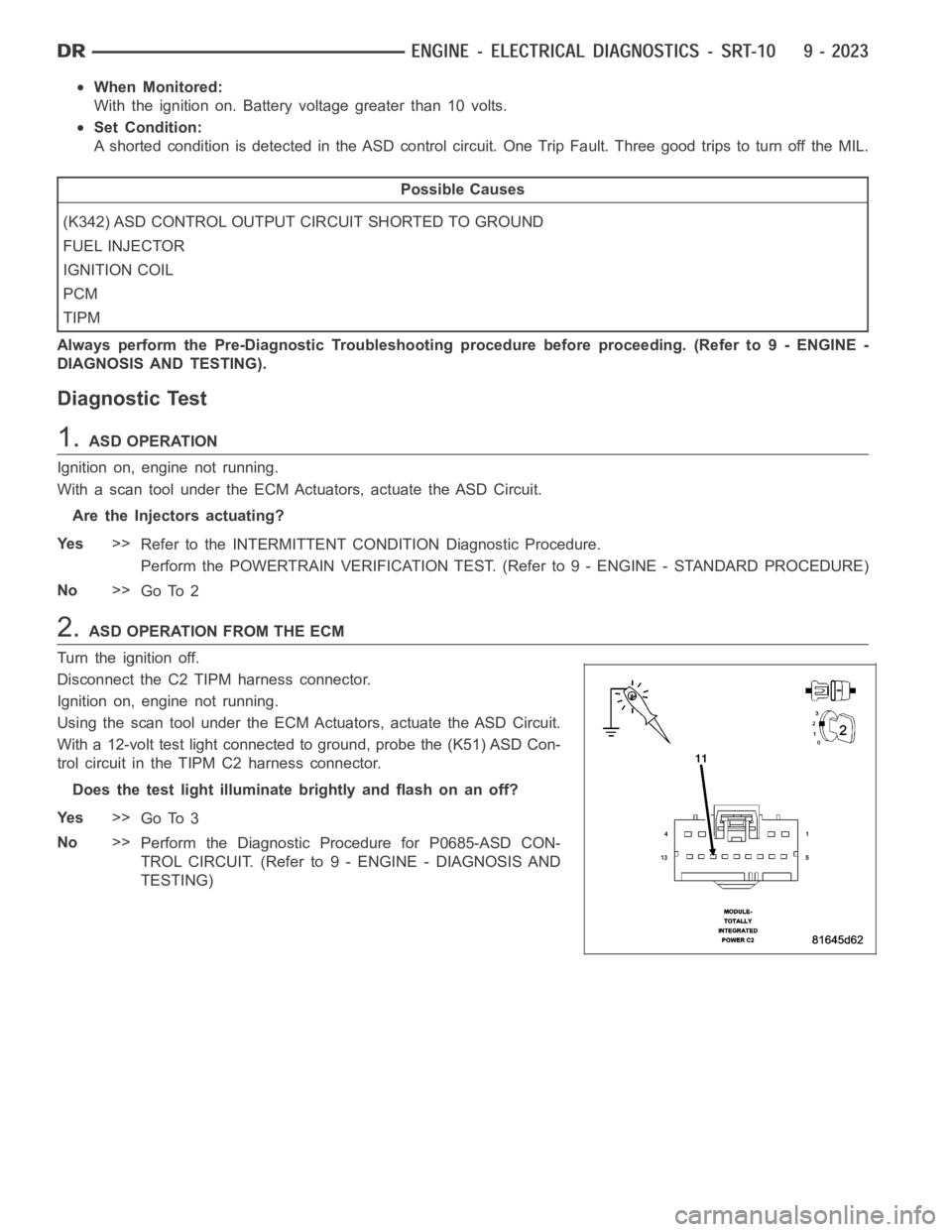
When Monitored:
With the ignition on. Battery voltage greater than 10 volts.
Set Condition:
A shorted condition is detected in the ASD control circuit. One Trip Fault.Three good trips to turn off the MIL.
Possible Causes
(K342) ASD CONTROL OUTPUT CIRCUIT SHORTED TO GROUND
FUEL INJECTOR
IGNITION COIL
PCM
TIPM
Always perform the Pre-Diagnostic Troubleshooting procedure before proceeding. (Refer to 9 - ENGINE -
DIAGNOSIS AND TESTING).
Diagnostic Test
1.ASD OPERATION
Ignition on, engine not running.
With a scan tool under the ECM Actuators, actuate the ASD Circuit.
Are the Injectors actuating?
Ye s>>
Refer to the INTERMITTENT CONDITION Diagnostic Procedure.
Perform the POWERTRAIN VERIFICATION TEST. (Refer to 9 - ENGINE - STANDARD PROCEDURE)
No>>
Go To 2
2.ASD OPERATION FROM THE ECM
Turn the ignition off.
Disconnect the C2 TIPM harness connector.
Ignition on, engine not running.
Using the scan tool under the ECM Actuators, actuate the ASD Circuit.
With a 12-volt test light connected to ground, probe the (K51) ASD Con-
trol circuit in the TIPM C2 harness connector.
Does the test light illuminate brightly and flash on an off?
Ye s>>
Go To 3
No>>
Perform the Diagnostic Procedure for P0685-ASD CON-
TROL CIRCUIT. (Refer to 9 - ENGINE - DIAGNOSIS AND
TESTING)
Page 1336 of 5267
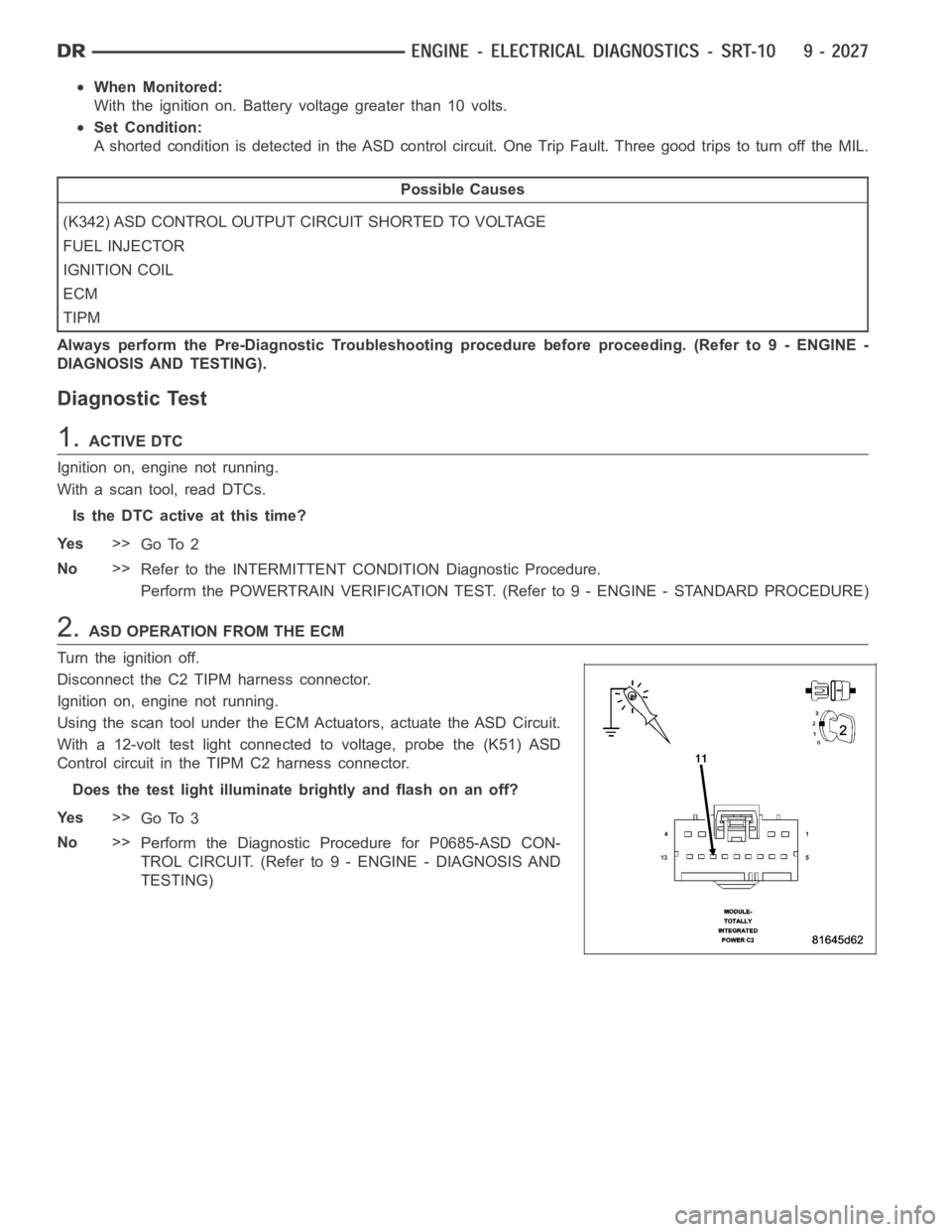
When Monitored:
With the ignition on. Battery voltage greater than 10 volts.
Set Condition:
A shorted condition is detected in the ASD control circuit. One Trip Fault.Three good trips to turn off the MIL.
Possible Causes
(K342) ASD CONTROL OUTPUT CIRCUIT SHORTED TO VOLTAGE
FUEL INJECTOR
IGNITION COIL
ECM
TIPM
Always perform the Pre-Diagnostic Troubleshooting procedure before proceeding. (Refer to 9 - ENGINE -
DIAGNOSIS AND TESTING).
Diagnostic Test
1.ACTIVE DTC
Ignition on, engine not running.
With a scan tool, read DTCs.
Is the DTC active at this time?
Ye s>>
Go To 2
No>>
Refer to the INTERMITTENT CONDITION Diagnostic Procedure.
Perform the POWERTRAIN VERIFICATION TEST. (Refer to 9 - ENGINE - STANDARD PROCEDURE)
2.ASD OPERATION FROM THE ECM
Turn the ignition off.
Disconnect the C2 TIPM harness connector.
Ignition on, engine not running.
Using the scan tool under the ECM Actuators, actuate the ASD Circuit.
With a 12-volt test light connected to voltage, probe the (K51) ASD
Control circuit in the TIPM C2 harness connector.
Does the test light illuminate brightly and flash on an off?
Ye s>>
Go To 3
No>>
Perform the Diagnostic Procedure for P0685-ASD CON-
TROL CIRCUIT. (Refer to 9 - ENGINE - DIAGNOSIS AND
TESTING)
Page 1340 of 5267
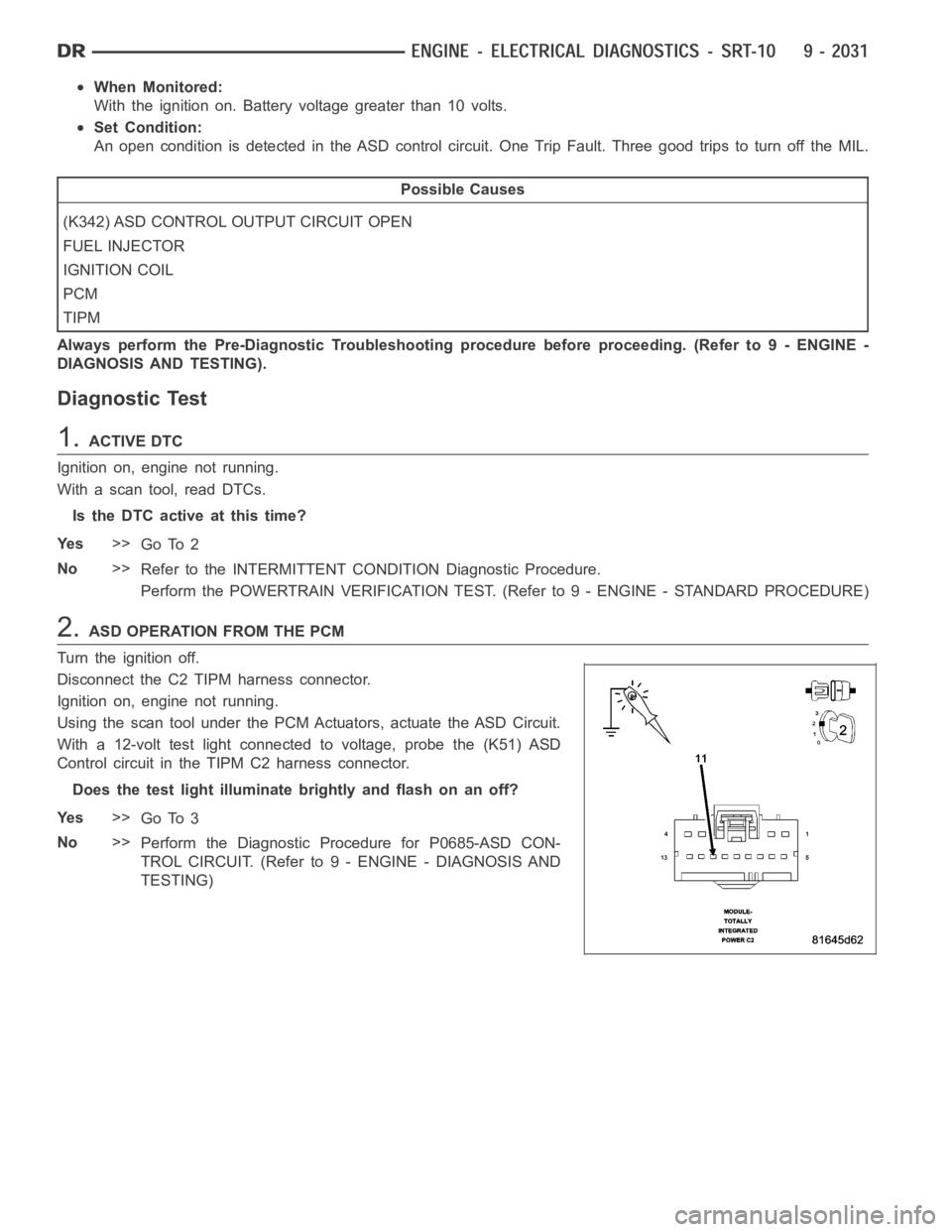
When Monitored:
With the ignition on. Battery voltage greater than 10 volts.
Set Condition:
An open condition is detected in the ASD control circuit. One Trip Fault. Three good trips to turn off the MIL.
Possible Causes
(K342) ASD CONTROL OUTPUT CIRCUIT OPEN
FUEL INJECTOR
IGNITION COIL
PCM
TIPM
Always perform the Pre-Diagnostic Troubleshooting procedure before proceeding. (Refer to 9 - ENGINE -
DIAGNOSIS AND TESTING).
Diagnostic Test
1.ACTIVE DTC
Ignition on, engine not running.
With a scan tool, read DTCs.
Is the DTC active at this time?
Ye s>>
Go To 2
No>>
Refer to the INTERMITTENT CONDITION Diagnostic Procedure.
Perform the POWERTRAIN VERIFICATION TEST. (Refer to 9 - ENGINE - STANDARD PROCEDURE)
2.ASD OPERATION FROM THE PCM
Turn the ignition off.
Disconnect the C2 TIPM harness connector.
Ignition on, engine not running.
Using the scan tool under the PCM Actuators, actuate the ASD Circuit.
With a 12-volt test light connected to voltage, probe the (K51) ASD
Control circuit in the TIPM C2 harness connector.
Does the test light illuminate brightly and flash on an off?
Ye s>>
Go To 3
No>>
Perform the Diagnostic Procedure for P0685-ASD CON-
TROL CIRCUIT. (Refer to 9 - ENGINE - DIAGNOSIS AND
TESTING)